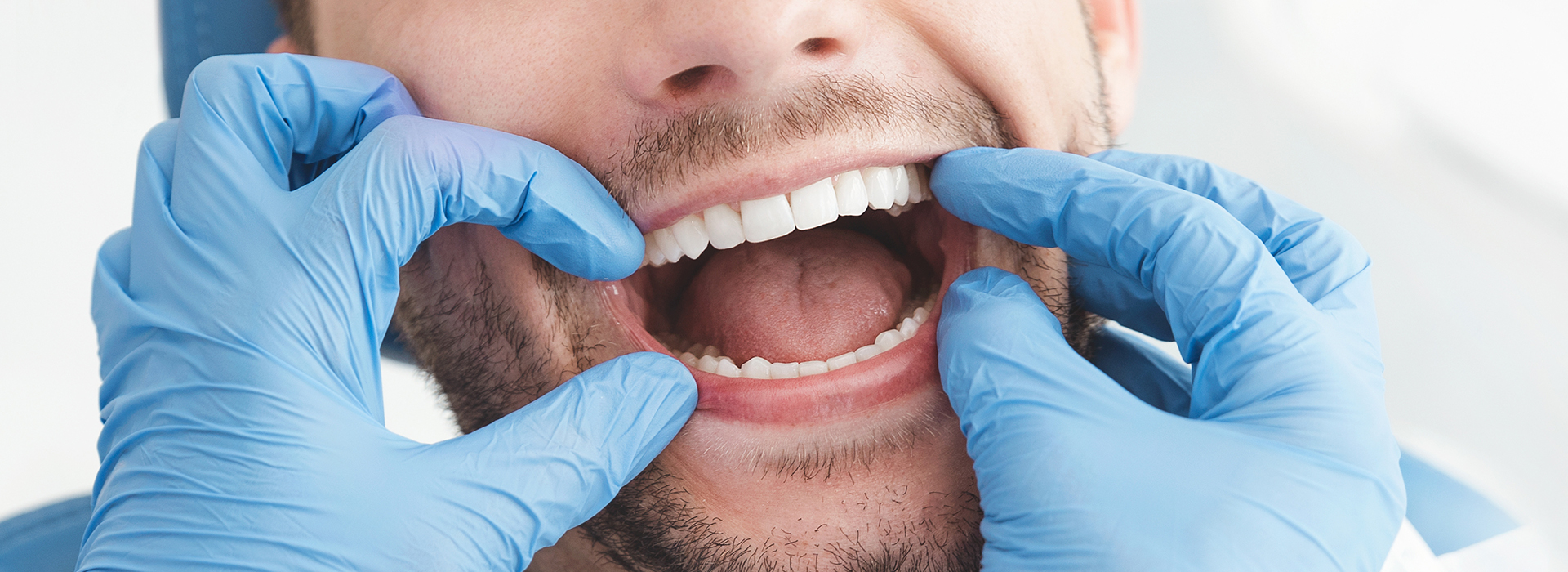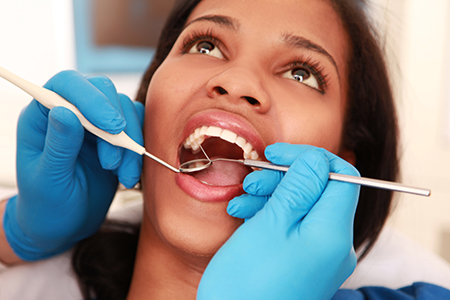Existing Patients
(740) 344-4549
New Patients
(740) 212-1897

At the office of Brian Howe DDS, Family Dentistry, we take a preventive-first approach to keeping smiles healthy. Regular oral exams give our team the chance to find small problems before they grow, to reinforce good hygiene habits, and to personalize care for each member of the family. Located in Newark, Ohio, our practice combines experienced clinicians with modern diagnostic tools so patients leave each visit with a clear understanding of their oral health and next steps when needed.
Routine oral exams are more than a quick check of teeth — they are a snapshot of your current oral health and a roadmap for preserving it. During a comprehensive exam, we evaluate tooth surfaces, gum tissues, bite relationships, and the function of the jaw joints. Identifying early signs of decay, gum inflammation, or abnormal wear allows us to recommend targeted interventions that are simpler and less invasive than treatments for advanced problems.
Exams also create continuity of care. When we track your dental health over time, patterns become apparent: areas that repeatedly collect plaque, changes in gum levels, or new areas of sensitivity. This trend data helps the care team tailor preventive strategies, from improved at-home routines to the timing of professional cleanings or topical treatments.
For families, routine exams are an investment in long-term oral health. Children, teens, and adults all benefit from consistent monitoring because the needs and risks at each life stage differ. Regular visits enable us to provide age-appropriate guidance and to catch developmental issues early, which supports better outcomes over a lifetime.
Your first visit establishes a baseline. We begin with a careful review of your medical and dental history so we understand any health conditions, medications, or habits that could affect oral care. Next, we perform a thorough clinical examination: each tooth is inspected, gum health is assessed, and the soft tissues of the mouth, tongue, lips, and surrounding areas are examined for any unusual changes.
Diagnostic imaging is recommended when needed to reveal what cannot be seen with the eye alone. X-rays or digital scans allow us to evaluate the roots of teeth, the bone that supports them, and developing or impacted teeth. Based on those findings and the clinical exam, we’ll outline any recommended next steps and discuss options with you in clear, straightforward language.
We also assess function — including bite alignment and jaw movement — and screen for habits like tooth grinding that can contribute to wear or pain. Throughout the appointment, our team emphasizes patient comfort and understanding, making time to answer questions and explain why particular observations matter for short- and long-term oral health.

Oral health is closely linked to general health. The tissues in the mouth often reflect conditions that affect the rest of the body, and conversely, systemic illnesses can produce oral symptoms. During an exam we look for signs that could indicate broader health concerns — persistent dry mouth, unusual ulcers, or gum inflammation, for example — and advise patients when further medical evaluation may be appropriate.
Research increasingly supports connections between oral disease and chronic health conditions. Poor oral health has been associated with issues such as digestive disorders, respiratory problems, cardiovascular disease, stroke, diabetes, and even cognitive decline. While the relationships are complex, keeping oral infections and inflammation under control contributes to overall wellbeing.
Because the mouth can show early signs of systemic disease, routine dental exams provide a valuable layer of preventive healthcare. Our team will note any worrying findings, document changes over time, and coordinate recommendations that help patients address both oral and general health concerns.
Digestive disorders
Respiratory Problems
Cardiovascular Disease
Stroke
Diabetes
Alzheimer's Disease

Regular cleanings work hand-in-hand with oral exams. Even diligent home care can miss the microscopic biofilm and mineralized deposits that form between teeth and along the gumline. A hygienist removes these deposits with gentle, professional tools and polishes tooth surfaces to reduce staining and improve comfort.
Beyond cleaning, preventive care includes personalized instruction on brushing and flossing techniques, dietary suggestions to limit decay-promoting habits, and targeted treatments where appropriate — such as fluoride applications or sealants for at-risk surfaces. We emphasize practical guidance that fits each patient’s lifestyle, helping families build routines that reduce the need for future restorative work.
Most patients benefit from regular checkups scheduled at intervals based on their individual risk profile. Twice-yearly visits are common, but those with certain conditions or increased vulnerability may require more frequent monitoring. The goal is simple: keep disease at bay, preserve healthy tissue, and make oral care manageable for patients of every age.
For children, preventive visits are also a chance to monitor growth and development. Early observation of jaw or tooth alignment helps determine whether orthodontic evaluation will be helpful later, and establishing positive dental experiences sets the foundation for lifelong oral health.
Visual inspection is essential, but images reveal the full story beneath the surface. Digital radiography and advanced 3D imaging allow us to examine tooth roots, bone levels, and structures that are hidden in a clinical exam. These tools support accurate diagnosis, enable precise treatment planning, and improve patient safety through lower radiation exposure compared with older film techniques.
Digital radiographs are immediate and can be reviewed with you during the visit so you understand any findings. They are stored in your electronic record for easy comparison over time, which helps us spot subtle changes early. For complex cases, three-dimensional cone-beam computed tomography (CBCT) provides a detailed view that is especially useful for implant planning, evaluating impacted teeth, or assessing bone structure prior to surgery.
Different images serve different purposes. Periapical and bitewing films help detect decay and root problems; panoramic films offer an overall view of the jaws and tooth development; and cephalometric films support orthodontic assessment. Together, clinical examination and imaging form a comprehensive diagnostic approach that guides conservative, evidence-based care.
An oral exam is the foundation of responsible dental care. When you rely on regular assessments, you empower your dentist and hygienist to preserve healthy tissue, intercept problems early, and tailor preventive care to your life. Our team aims to make each visit informative, respectful, and focused on practical strategies that keep smiles healthy for years.
At Brian Howe DDS, Family Dentistry, we’re committed to delivering careful exams and clear explanations so patients feel confident about their oral health decisions. If you’d like to learn more about what an oral exam involves or to schedule a visit, please contact us for more information.
At the office of Brian Howe DDS, Family Dentistry in Newark, Ohio, an oral exam is a comprehensive assessment of the teeth, gums and supporting structures. It goes beyond a quick visual check to evaluate soft tissues, bite function and other signs of oral disease. Exams establish a baseline that guides preventive care and future treatment decisions.
Clinicians use the exam to detect early decay, gum inflammation, abnormalities in the mouth and indicators of systemic health concerns. The process commonly includes a clinical inspection, palpation of soft tissues and an evaluation of jaw movement and bite. Findings are documented so changes can be tracked over time.
Routine oral exams identify small problems before they require extensive treatment, making care less invasive and more predictable. They allow the dental team to recognize patterns such as recurrent plaque buildup or shifting gum levels that inform personalized prevention plans. Regular monitoring reduces the risk of emergency issues and supports long-term oral health.
Exams also help limit chronic oral inflammation, which can affect overall wellbeing, and they keep restorations and prosthetic devices functioning properly. Consistent visits provide opportunities to coach patients on effective home care and habit modification. For families, routine exams deliver age-appropriate guidance that adapts as children grow and adults age.
A comprehensive exam begins with a review of medical and dental history to identify conditions, medications or habits that influence oral care. The dentist inspects each tooth, evaluates gum tissues and checks the soft tissues of the mouth while assessing bite and jaw function. The clinician also screens for signs of oral cancer and other abnormalities that warrant attention.
When indicated, diagnostic imaging such as digital radiographs or three-dimensional scans supplements the clinical exam to reveal root conditions, bone levels and impacted teeth. Findings are reviewed with the patient in clear language and recorded in the chart. Together, clinical examination and imaging form a treatment roadmap tailored to the patient's needs.
Frequency of exams depends on individual risk factors including gum health, history of decay, systemic health conditions and habits such as tobacco use or grinding. Many patients benefit from twice-yearly visits, while those with elevated risk may require more frequent monitoring to manage disease and preserve tissue. Your dental team will recommend an interval based on clinical findings and preventive goals.
Risk-based scheduling allows care to be proactive rather than reactive and focuses attention where it has the most impact. During follow-up appointments, clinicians compare current findings to previous records and images to spot subtle changes. This personalized schedule helps maintain oral stability and avoid unnecessary procedures.
The mouth often reflects systemic conditions, and oral exams can reveal early indicators such as persistent dry mouth, unusual ulcers or generalized gum inflammation. Dentists look for patterns that may correlate with conditions like diabetes, autoimmune disorders or nutritional deficiencies and advise when medical evaluation is appropriate. While dental exams do not replace medical diagnostics, they are an important part of early detection and referral.
Documentation of oral findings and communication with a patient's medical providers can improve overall care coordination. Maintaining oral health reduces inflammatory burden and may support broader disease management. When concerning signs appear, the dental team will recommend next steps and help patients pursue appropriate medical follow-up.
Common diagnostic tools include digital radiography, panoramic imaging and cone‑beam computed tomography (CBCT) when detailed three‑dimensional visualization is required. Digital images provide rapid, lower‑dose views of decay between teeth, root conditions and bone levels that are not visible on clinical exam. Panoramic and 3D scans are used selectively for implant planning, evaluating impacted teeth and assessing complex anatomical relationships.
Intraoral cameras and tactile assessment also enhance diagnosis by highlighting surface details and enabling patient education. Images are stored in the electronic record for comparison over time, which helps clinicians detect subtle progression. Together, clinical examination and imaging enable precise, evidence‑based recommendations.
Professional cleanings remove hardened deposits and microscopic biofilm that routine home care can miss, reducing inflammation and the risk of decay. During cleaning appointments, hygienists polish tooth surfaces and provide targeted instruction on brushing and flossing techniques that address each patient's trouble spots. These sessions complement the oral exam by keeping tissues healthy between evaluations.
Preventive strategies may also include topical fluoride applications or sealants for vulnerable surfaces based on exam findings. Education about diet, tobacco cessation and habit modification is tailored to an individual's risk profile. When combined with regular exams, cleanings form the cornerstone of conservative, preventive dentistry.
Exams are tailored to the patient's age and developmental stage; pediatric visits focus on growth, eruption patterns and habits that influence development. Clinicians monitor jaw and tooth alignment early to identify issues that may benefit from orthodontic evaluation and work to establish positive dental experiences for young patients. Age‑appropriate home care instruction and anticipatory guidance are central to pediatric exams.
Adult exams emphasize restorative history, periodontal health and the effects of systemic conditions or medications on the mouth. Older adults may require additional monitoring for root decay, recession or changes in prosthetic devices. Across all ages, exams aim to preserve function, comfort and long‑term oral stability.
If the exam reveals decay, gum disease or other concerns, the dentist will explain the finding and outline conservative treatment options and timelines. Recommendations often prioritize minimally invasive interventions to preserve natural tooth structure and address inflammation. The care team will answer questions and document the agreed plan in the patient's record.
When complex care or specialty input is needed, the dentist may coordinate with specialists and share relevant images and records to support seamless treatment. Follow‑up intervals may be adjusted to monitor healing or response to therapy. Clear communication ensures patients understand the rationale for each next step and how it fits into their overall oral health goals.
Prepare by bringing an up‑to‑date list of medications and a summary of your medical history to help the dental team assess risk factors. Note any symptoms such as sensitivity, pain, dry mouth or changes in the mouth and be ready to discuss habits like tobacco use or clenching. Good oral hygiene before the visit helps clinicians perform a thorough examination and makes the appointment more efficient.
Inform the practice about any recent surgeries, pregnancy or new diagnoses that could affect dental care and mention any concerns about comfort or anxiety when scheduling. The team can then discuss options to improve your experience and ensure appropriate precautions are in place. Clear communication and preparation help the dentist deliver focused, effective care during the exam.
Our friendly and knowledgeable team is always ready to assist you. You can reach us by phone at (740) 344-4549 or by using the convenient contact form below. If you submit the form, a member of our staff will respond within 24–48 hours.
Please do not use this form for emergencies or for appointment-related matters.
